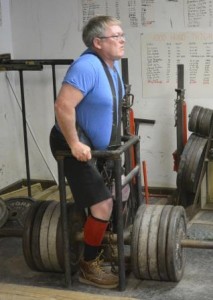By Bill Clark
MEET –
BACKBREAKER PENTATHLON

Three legends of Clark’s Gym gather for the Backbreaker (left to right): Steve Schmidt, Bill Clark, and John Carter (caption by webmaster)
John Carter was an easy winner, his second title in a month, capturing the best lifter award in Steve’s Back breaker Pentathlon held at Clark’s Gym in Columbia, Mo.
The field was limited to only three lifters due to the corona virus and restricted movement. What had been planned as a warm-up for the USAWA National Heavy Lift Championships in May, wound up being a friendly day in the gym and plenty of time to visit with Steve Schmidt, the USAWA Hall of Famer for whom the meet is named.
Steve served as the head meet official and passed along a few coaching hints as well – much to everyone’s gratitude. It was much like the days of old at Clark’s place – only the size of the crowd was different.
Amorkor Ollennuking continued her comeback from lymph node cancer treatment by performing what everyone consider the best life of the day. During the record session, the 57-year-old Kansas Citian did a little fingers deadlift with 125 pounds, breaking the long-standing mark of Mary McConnaughey. It is the highest little fingers deadlift by a female regardless of weight or age, in the USAWA record book.

Dave DeForest pushing up a big Harness Lift!
The busiest lifter of the day was 60-year-old Dave DeForest, who, like Carter, has revived a lifting career dormant for more than a decade. He set records in the harness, hip and hand-and thigh, then added five more during a record session.
Carter, too, set three records – hip, harness and back lifts.
Clark’s has put the outside competition on hold because of the corona virus, but will lift in the USAWA quarterly postal competition.
The results:
2020 Backbreaker Pentathlon
March 21st, 2020
Clark’s Gym
Columbia, MO
Meet Director: Bill Clark
Scorekeeper: Bill Clark
Officials (1-official system used): Bill Clark, Steve Schmidt
Photographer: Gene Baumann
LIFTERS:
Amorkor Ollennuking, 57, Female, Kansas City, Mo. Bwt. 76.9 kilos (169.5 lbs). Coefficient – .9896. Age differential – 1.18.
John Carter, 61, Male,Harrisburg, Mo. Bwt – 98.9 kilos (218 lbs.) Coeff. – .8522. Age diff. – 1.22.
Dave DeForest, 60, Male, Fulton, Mo. Bwt – 89.4 kilos (197 lbs.) Coeff. – .9060. Age diff. 1.21.
BACK LIFT
Ollennuking – 900
Carter – 1500
DeForest – 800
NECK LIFT
Ollennuking – 200
Carter – 225
DeForest – 250
HAND AND THIGH
Ollennuking – 705
Carter – 900
DeForest – 705
HIP LIFT
Ollennuking – 765
Carter – 1670
DeForest – 1125
HARNESS LIFT
Ollennuking – 1075
Carter – 2105
DeForest – 1305
TOTALS
Ollennuking – 3,645 lbs.
Carter – 6,400 lbs.
DeForest – 4,185 lbs.
BODYWEIGHT ADJUSTMENT
Ollennuking – 3,588.87
Carter – 5,594.08
DeForest – 3,791.61
AGE ADJUSTMENT – FINAL SCORE
Ollennuking – 4,234.86
Carter – 6,657.98
DeForest – 4,582.85
SUCCESSFUL FOURTH ATTEMPTS
DeForest – Hand-and-thigh – 805; Hip lift – 1,225.
RECORD DAY
Ollennuking – Little fingers deadlift – 125.
DeForest – Snatch on knees – 80; strict curl – 80; right hand one-inch vertical bar deadlift – 182; left hand one-inch vertical bar deadlift – 182; two-hand 1-inch vertical bars deadlift – 314

